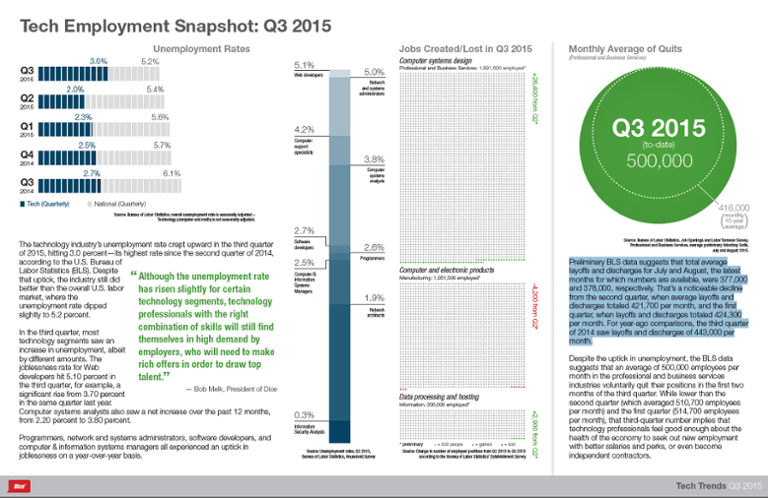Tech Unemployment Rises In Some Categories
The technology industry’s unemployment rate crept up to 3.0 percent in the third quarter of 2015, according to the U.S. Bureau of Labor Statistics (BLS). Although that represents an increase from the second quarter, when tech unemployment stood at 2.0 percent, it’s nonetheless lower than the 5.2 percent unemployment rate for the U.S. labor market as a whole. Many technology segments saw an accompanying rise in joblessness. Web developers, for example, saw their collective unemployment rate hit 5.10 percent, up from 3.70 percent in the same quarter last year. Computer systems analysts, programmers, network and systems administrators, software developers, and computer & information systems managers likewise experienced a slight rise in unemployment on a year-over-year basis. But does that mean the tech economy is softening? Other indicators suggest the overall industry remains strong. Layoffs and discharges for July and August, the latest months for which the BLS had preliminary data, hit 377,000 and 378,000, respectively. That represents a decline from both the first and second quarter, when the layoff and discharge rate stood at more than 400,000 per month. In the third quarter, voluntary quits among tech pros also remained robust, with an average of 500,000 employees per month deciding to quit their jobs. Analysts tend to interpret higher numbers of voluntary quits as a sign that employees are feeling positively enough about the economy to leave their current positions in order to pursue better opportunities. If there’s one bleak spot in this quarter’s economic reading, it’s manufacturing, which continues to suffer from weak demand for electronic products and hardware. That’s not a new tale; with the substantial majority of tech manufacturing taking place in Asia, and most of the nation’s tech hubs centered around companies devoted to software, the number of available manufacturing jobs in the U.S. has slowly but steadily declined. When it comes to the health of the broader tech economy, the numbers to watch are the respective unemployment rates for Web programming and other “hot” categories. For the moment, despite some upticks, those numbers remain largely positive for tech pros.



